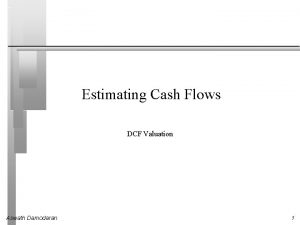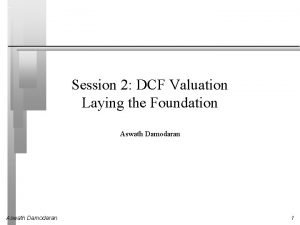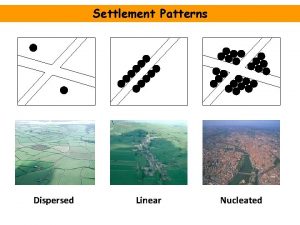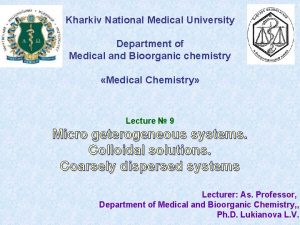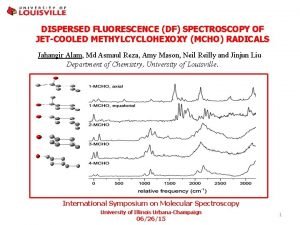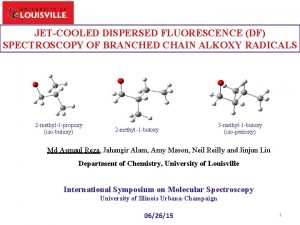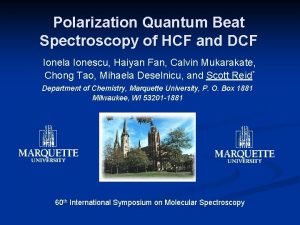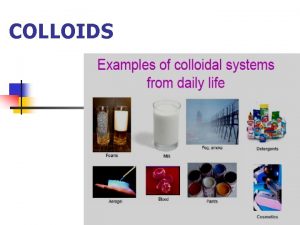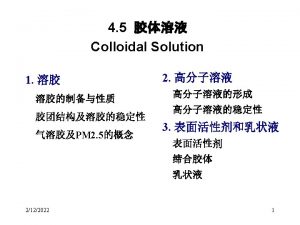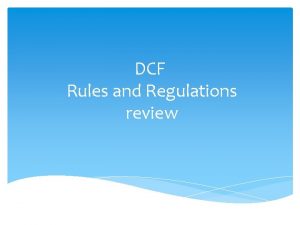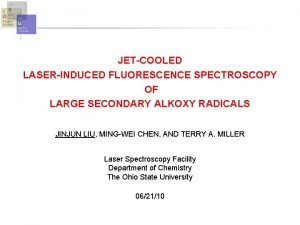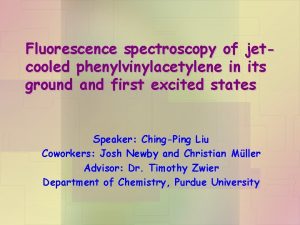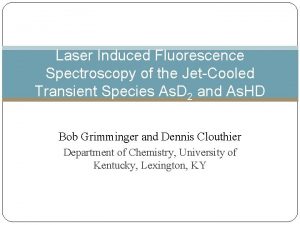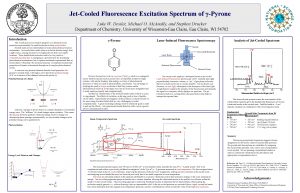Dispersed fluorescence studies of jetcooled HCF and DCF













- Slides: 13

Dispersed fluorescence studies of jet-cooled HCF and DCF: Vibrational Structure of the X 1 A state

Objectives Obtain dispersed fluorescence (DF) spectra in the Ã1 A" ←X 1 A' system of HCF and DCF following excitation of pure bending transitions and combination bands. l Fit the experimental term energies of both species to an effective Hamiltonian (Dunham expansion). l Compare experimental parameters with ab initio calculations. l Search for perturbations involving low-lying triplet state, predicted to lie ~ 5200 cm-1 above the ground state. To date the vibrational structure has been probed only up to ~4200 cm-1 above the vibrationless level. l

Literature review l l l Chang and co-workers observed ã 3 A" perturbations in DF spectra of HCCl and HCBr and estimated the Singlettriplet energy gap (∆EST), which was consistent with theory. For HCF, predicted values for ∆EST range from 46175537 cm-1 consistent with an experimental value of 5210± 140 cm-1 derived from photoelectron spectra of HCF- by Lineberger and co-workers. Jacox and Mulligan reported infrared spectra of HCF and DCF and reported values for v 2 (bend) and v 3 (CF stretch). Suzuki and Hirota reported DF and Stimulated Emission Pumping (SEP) spectroscopy of HCF from 00 and identified resonance between 11 and 2131. Lineberger and co-workers reported values for ν 3 of HCF and DCF from photoelectron spectroscopy of the corresponding negative ions.

Methodology HCF and DCF were generated by pulsed electrical discharge through a 1 -2% mixture of CH 2 F 2(obtained commercially) or CD 3 F(synthesized from CD 3 OD via a Literature procedure) in Ar. l The laser system is an etalon narrowed dye laser (Lambda-Physik Scanmate 2 E) pumped by third harmonic of a Nd: YAG laser (Continuum NY-61 or Powerlite 7010). l DF spectra were acquired using a 0. 3 m spectrograph with 600 or 1800 l/mm grating and gated intensified CCD detector. l Spectra were acquired in photon counting mode, over typically 5000 laser shots with 100 mm slit width. l

Results and Discussion l This shows DF spectra for HCF obtained by exciting r. Qo bandhead in The x-axis is the vibrational energy in the X 1 A' state. l Two features are observed for each vibrational state, corresponding to transitions to ground state levels with Ka = 0, 2. l Excitation of various overtone and combination bands allowed Franck-Condon access to the majority of X 1 A' levels. l

Effective spectroscopic Hamiltonian (Dunham Expansion) l DCF ¡ The term energies are well described by this model. ¡ A total of 40 levels were included in the fit and yielded a standard deviation of 1. 9 cm-1. l HCF ¡ ¡ ¡ This model poorly reproduces the term energies. Fitting all levels yields standard deviation of 22 cm-1. This is due to resonance between the set of levels 112 n, 2 n+131 and 2 n+2. Only 18 levels are included in the fit that yields a standard deviation of 4. 5 cm-1 (omitting 112 n, 2 n+131).

X 1 A' vibrational term energies fit parameters (in cm-1) Parameter HCF DCF w 1 w 2 w 3 2666(6) 1999. 2(16) 1417(2) 1062. 2(5) 1194(5) 1203. 9(17) x 11 -26(3) -35. 1(8) x 22 -3. 4(3) -1. 33(8) x 33 -5. 4(27) -9. 6(9) x 12 -56. 8(22) -29. 56(26) x 23 -26. 8(15) -6. 54(22) x 13 -5. 0(23) -2. 4(13) x 123 ------- -0. 2(5)

Comparison of experiment and theory for the vibrational frequencies of DCF and HCF in X 1 A' Method ω1 in cm-1 ω2 in cm- ω3 in cm 1 -1 2767 1437 1198 2710(6) 1461(2) 1213(5) 2032 1078 1199 HCF o. B 3 LYP/aug-ccp. VTZ o. Experiment (DF) DCF o. B 3 LYP/aug-ccp. VTZ o. Experiment (DF) 2032. 7(18) 1080. 9(5) 1213(19)

HCF l An effective Hamiltonian which incorporated diagonal terms and Fermi resonance matrix elements between 112 n, 2 n+131 was utilized. l A fit to 33 levels improved the standard deviation from ~22 cm-1 to ~11 cm-1. l Higher order terms will need to be included to fully describe the intra-polyad coupling.

Searching for the triplet state A complicated vibrational structure is observed in HCF near the predicted position of the ã 3 A" origin. l We expect a significantly larger A constant for triplet perturbed levels, as the calculated A constant for the vibrationless level of ã 3 A" is ~23 cm-1. l All six levels in this region display an A constant consistent with assignment to X 1 A', i. e. , the derived constants fall between ~14. 5 and 16. 5 cm-1. l

Searching for the triplet state This observation is also true at higher energies, although the constants increase on average. l We thus have not identified perturbations l involving the ã 3 A" state – this may be due to small spin-orbit matrix elements (~ 0. 5 cm-1 in the Ã1 A' state).

Conclusions l l l DF spectra were recorded following excitation of the pure bending levels and the combination states in the Ã1 A" ←X 1 A' system of HCF and DCF. This reveal rich detail concerning the vibrational structure of the X state up to ~ 10 000 cm-1. An effective spectroscopic Hamiltonian (Dunham expansion) works well for DCF but poorly reproduces the experimental term energies of HCF, where the spectra are complicated by resonances among the set of levels 112 n, 2 n+131 and 2 n+2. Density functional calculations of the ground state vibrational frequencies were performed; the results are in excellent agreement with the experimentally derived vibrational parameters. The search for perturbations involving the low-lying triplet state has to this point been unsuccessful – due to the small matrix elements, rotationally resolved spectra will be needed.

Acknowledgements l Petroleum Research Fund l National Science Foundation
 Dcf project management
Dcf project management Mandated reporter training massachusetts
Mandated reporter training massachusetts Damodaran dcf
Damodaran dcf Dcf sensitivity analysis
Dcf sensitivity analysis Relative valuation vs dcf
Relative valuation vs dcf Dcf aswath
Dcf aswath Da cum formula
Da cum formula Dcf careline 136
Dcf careline 136 Fsfn production login
Fsfn production login Damodaran erp
Damodaran erp Disadvantage of nucleated settlement
Disadvantage of nucleated settlement What is nucleated settlement
What is nucleated settlement Dispersed phase and dispersion medium
Dispersed phase and dispersion medium Linear settlement pattern
Linear settlement pattern


